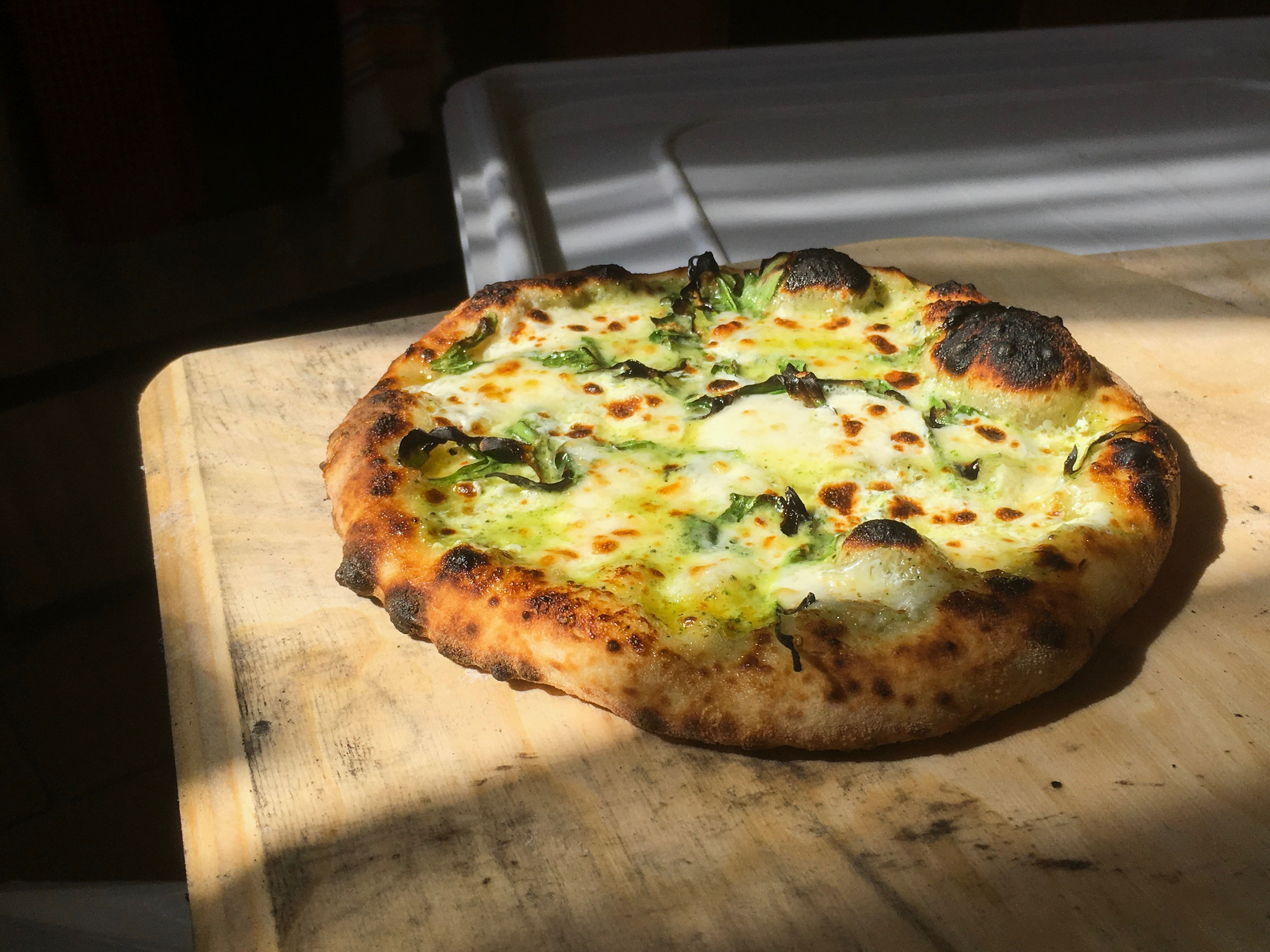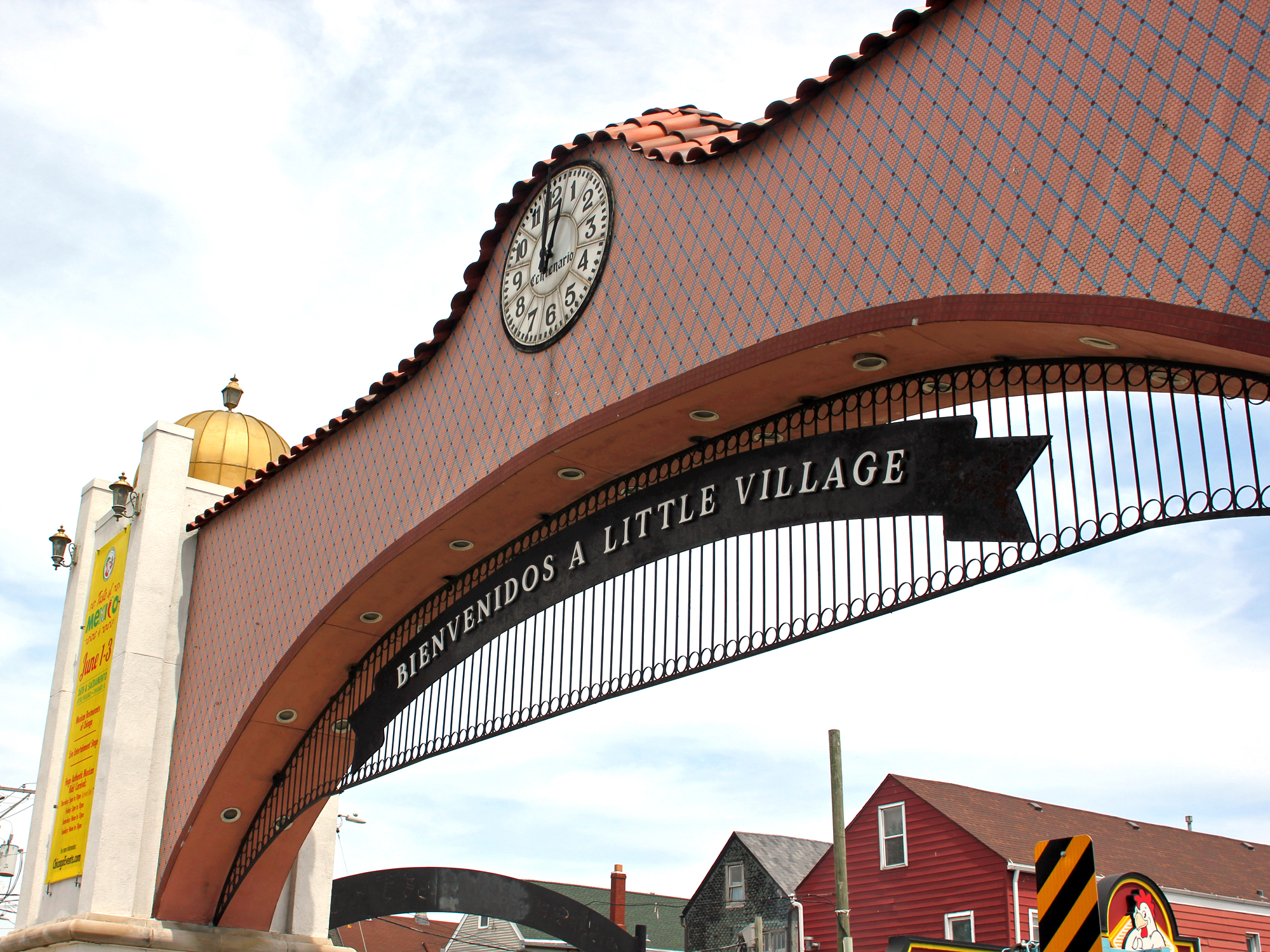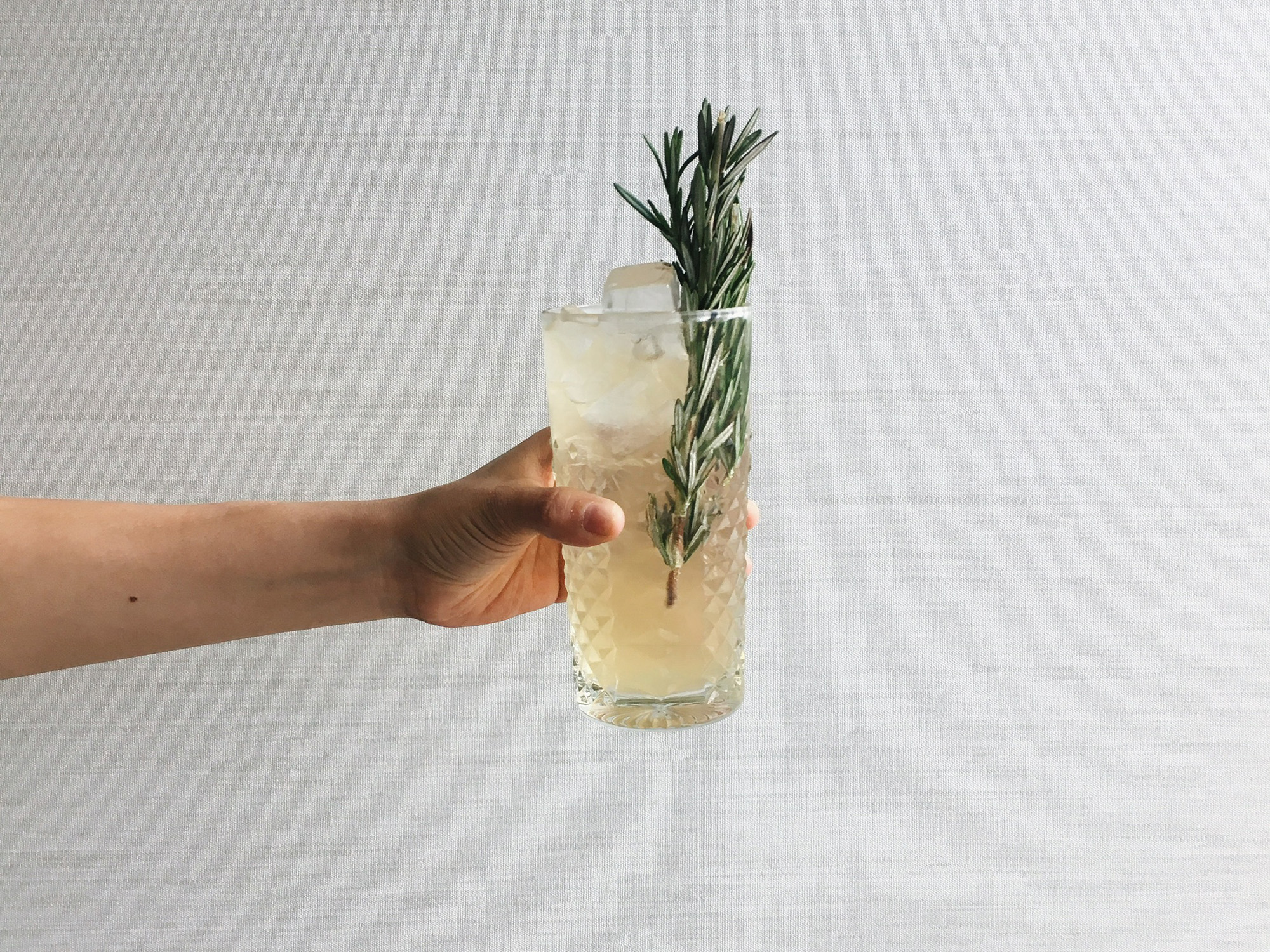IF YOU WERE TO ASK CHICAGO FOOD & DRINK writers to name the growth area on our scene right now, they might say rooftop bars. Being able to drink with the lights of a great city as your backdrop is one of those few things that can fairly be described as magical, without fear of puffery.
Of course, this isn’t a business it’s easy to get into—it really helps if you already have a building in a prime downtown location. Which is how we find the Peninsula Hotel, opened in 2001, now adding on a new bar space six floors above Tiffany’s Michigan Avenue store. (Actually, relative to the hotel part of the building, it’s on the sixth and a half floor, but don’t worry about short ceilings a la Being John Malkovich.)
The new 130-seat bar, set to open next Monday, June 18, will be called Z-Bar, and its beverage program will be run by Vlad Novikov, who was born in St. Petersburg, grew up in Chicago, went to school to learn chemistry in the Quad Cities—and apparently got hooked on the part about pouring liquids in and out of glasses. At least, dapper as he is in formalwear, he keeps talking about his craft in terms of sharing his own cocktail geekiness with the world.
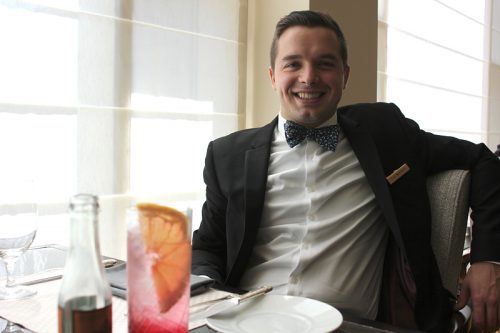
Vlad Novikov
This is a big investment for the hotel in something kind of personal and ephemeral, the mood and good vibes of a nice night out, as interpreted for you by a professional cocktail nerd. And so it was interesting for me to sit with Novikov and ask him how he approaches creating that night to remember for a bar full of guests in every area, from the drink menu to the playlist to training the serving staff. Here’s what he told me—sitting in The Lobby at the Peninsula, because Z-Bar was still under construction.
Getting Interested in Cocktails
Looking back, there were a lot of hints along the way. I used to buy antique glassware at garage sales as a kid. When I did a science fair project, it was perception of different volumes in different glasswares. I was 12 or 13 years old and having people measure things out of a graduated cylinder into a martini glass, or a brandy glass, or a snifter and see how they perceived them.
Even when I played video games, there was a really nerdy game called Runescape, and there was a very very small portion of it in the gnome area where you could make in-game cocktails. And I spent hours doing that.
I’m Russian, of course, and first of all you don’t ever meet, or talk, unless you have something to drink. And you never have something to drink unless you also have something to eat with it. It’s just understood, and it’s obvious, to the point that my mother, we were having dinner in one of the outlets here and she refused to touch her dessert until her cappucino had arrived. So for me, it was inevitable.
The first outlet I had growing up was through cooking. The first book I ever received was a cookbook. In my house, everything was cooked like Russians cook, till it was well done and then another half hour.
I studied chemistry in college, Augustana College in Rock Island, which to this day really helps with my work. When some of my friends would take their $12 and buy a 30-case of Keystone, I would take my $12 and I would get a six-pack of nice craft beer. I really got into it through beer and some homebrewing in college—one of my friends, in fact, who was in microbiology, is now a brewer for Goose Island. So I’m applying my chemistry and he’s applying his microbiology.
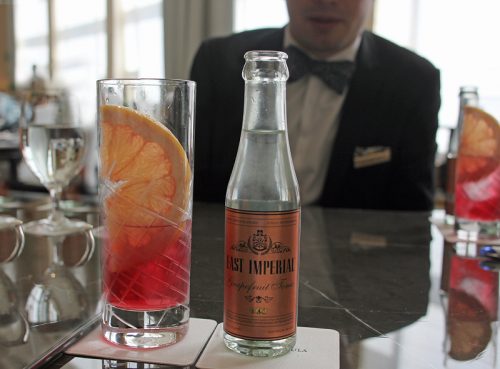
A non-alcoholic cocktail—Seedlip non-alcoholic spirit with botanicals, with Vlad’s favorite grapefruit tonic
Path in the Industry
My first bar job was at Rock Island Brewing in college. After college I moved to Chicago and you know where my first job was? It was at Hamburger Mary’s. I was thrilled, because they used fresh mint. That was groundbreaking, coming from the Quad Cities.
I quickly started working another couple of days a week at another craft beer bar, Elixir, owned by LKH Management, and within a year I was doing consulting for other bars on the north side, and then I went to open Revival Social Hall in Edgewater. That was really important for me because I was able to go back to LKH and say, I can do this. I opened four other venues for them, doing the full beverage program and training the staff.
I want this to be an after-work spot. I want people to skip out of work an hour early, and come to our bar at 4 pm, and have a couple of cocktails, and then all of a sudden the sun is setting.
But I was in Andersonville, I was in Lakeview. There was a lot more that I wanted to accomplish that I didn’t feel like I was in the right place to accomplish. I strongly believe that if you build it they will come—but they’re not going to come to Andersonville for it.
So I took a lateral move and went to work as a marketing manager and brand ambassador for a mescal company. That was really valuable, because I got to see the other side of the industry. But I wanted to do a bar program downtown, and the Peninsula seemed like the best possible thing that could have happened.
The Mood on the Six-and-a-Halfth Floor
Our purchasing manager found this really great DJ, Alyson Calagna, and she’s done a playlist that’s broken down by the hours of the day, down to the beats per minute and the mood. The best way I can describe this is, getting lost in the space and not realizing what time it is.
The main bar area, there’s huge windows, fourteen, fifteen feet high, and a gigantic skylight outside the bar. So whatever the mood is outside, it’s transferred very beautifully to the inside. It’s not like we’re dimming the lights and making nighttime fun—the Earth is dimming the lights. As it gets a little bit later, the music changes, it picks up in pace. You come in after work, you drink for a couple of hours, you get hungry, we have a full kitchen, and you suddenly realize, hey, it’s eight or nine o’clock. It’s very comfortable, but I think it has the flexibility to be very lively. There’s no dance floor, but I hope people get up and dance, and move, and get excited.
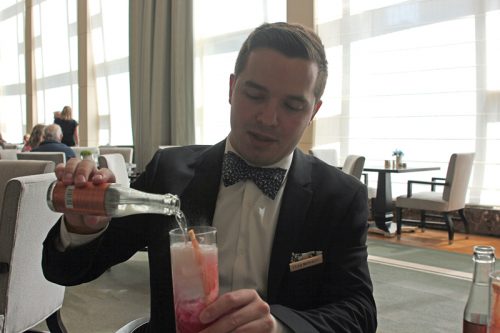
His List, At Last
Some of the cocktails on this list, I’ve wanted to do for years. Or I’ve had one version of it on a previous menu. But now I have the resources and the platform to really do it, and I hope people will enjoy it.
I have this Greek cocktail, and it has mastika in it. I’ve done a ton of mastika cocktails in the past, because I think it’s a totally underrated spirit, unique and delicious—I think everyone should be drinking it. Previous places, we couldn’t charge more than nine or ten dollars for it, and if one of my garnishes cost fifty cents, it’s not going to happen. But here, we were able to get these baby peaches from Japan, so we’re able to do that.
I’ve wanted to do a bottled Cosmo for a long time, but I was never anywhere that could afford carbonation equipment. So now I can do that—a bottled Cosmo, a bottled Aviation. It’s just a bottled Cosmo, maybe it’s not such a big deal, but we’re going to serve it in a bucket, like champagne.
That would be great for room service.
I’m going to long term ninja and invade every part of this hotel, but I gotta open up one bar at a time. But I like where your head’s at.
Philosophy of Mixology
There’s nothing that we have that hasn’t been done somewhere in the world. There’s nothing groundbreakingly novel—we’re not using ox blood in a cocktail. Everything that I’m trying to do is deeply rooted in classics. It’s elegant, it’s restrained, it’s intentional—but it’s also playful.
That intentional nature is, I think, the biggest thing. We have an Old-Fashioned on the menu. It’s not an Old-Fashioned with one weird liqueur in it. It’s an Old-Fashioned, and it’s got bourbon—a really great bourbon. It’s got unrefined cane sugar—sugar, but cane sugar. It’s got aromatic bitters, barrel-aged bitters from a place, I bought all of it that’s made, because I know the guys.
And yeah, we put a walnut on it, but it’s an Old-Fashioned. But it’s a really good Old-Fashioned, and at the end of the day that’s kind of my philosophy and my goal.
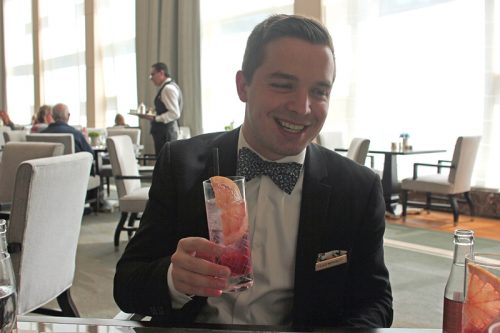
All the Glassware a Kid Could Want
The original idea for the bar called for everything to be served in antique glassware. And when you look at the physical space you realize, there’s no way. There are a few bespoke pieces—one of our cocktails comes in this stunning peacock glass—but most of the glasses have to have multiple uses.
What I look for in glassware is, it needs to be classic, it needs to be elegant, it needs to be textural. When you hold this [grabs his etched glass], it’s texturally exciting. This is a nice glass to hold, it has a nice weight to it, and it has a sheer rim. You pick up the glass and you feel good already. I think stemware is meant to—as if I was presenting your cocktail to you in my hands. I’m presenting you with this gift. They have to make you feel the way the drink makes you feel.
We have these spinning rocks glasses, they’re so cool. The center part is .1 millimeter larger than the outer edge, so on a flat service, it’ll spin. I don’t want the servers to tell anyone that—I want them to drop the drink at the table, and then I just want them to nudge it and start it spinning. So that there’s a double-take like—whuh? if you order an Old-Fashioned, I don’t want them to say, “Oh, you’re going to love it, it comes in a glass that spins”—let them discover it.
People Make Good Cocktails Great
We spend so much time talking about the cocktails and the glassware, but I’m really excited about the team that we have. We’re incorporating the current bar team but we’re adding about twice as many new people, and we’ve done about a month of training, pretty intense.
I always say, you can make a really good cocktail on a piece of paper—I give them good cocktails. And then when they make them, they’re great, if they execute them properly.
I had an issue at another bar with a bartender. I said, I need you to remake this Manhattan. And he said, people love my Manhattans. And I said to him, of course they love your Manhattans, because they’re good. I made the recipe, I picked the liquor, they’re always going to be good. But if you want them to be really really great, this is what I need you to do. So I showed him, stir it this way, do this, and he finally said, yeah, I can tell why this is better. So that’s the thing. A good cocktail is on a piece of paper, but you have to make the great cocktail, it doesn’t make itself.
Even people who had cocktail experience, we took them through the full training. There’s lots of ways to skin a cat, and when I’m hiring I would rather have someone who cooks at home and is passionate about food than someone who has ten years experience bartending. I can teach you how to make a Manhattan, but I can’t teach you to care, I can’t teach you how to be engaged in what you consume.
When I hire you, the first thing I ask is if you cook at home, because then I know that you create things, I know that you’re paying attention to what you consume. I ask them to tell me about it. If you can’t tell me in an excited, passionate way about something that you made, how are you going to do it with the cocktails?
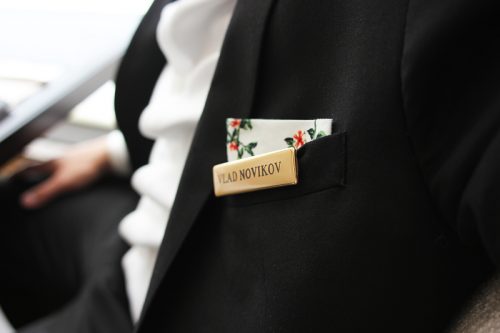
Who Are You Trying To Make Happy?
It’s an impossible task to make everybody happy. But I think we’ve done a good job of making something that is familiar and accessible for our clientele in the hotel—we are in the Peninsula, it’s not a freestanding structure. But we’ve tried to make it playful and fun—using mastika, we have an aquavit cocktail, using dill and Besk. We’re doing nerdy things, but they’re packaged in an accessible way. None of the drinks come with instructions. I don’t think drinks should come with instructions. I think if you can’t figure it out by looking at it, we should do it differently.
I want this to be an after-work spot. I want people to skip out of work an hour early, and come to our bar at 4 pm, and have a couple of cocktails, and forget that they’re there. Maybe one of their friends comes and joins them, and then all of a sudden the sun is setting. I want this to be an escape, and I want it to be something for people who work in the area, and people who live in the area.
Michael Gebert has a fabulous office on the 6-1/2th floor of Fooditor Tower.
Latest
Join the Discussion
After you comment, click Post. If you're not already logged in you will be asked to log in or register with Disqus.





